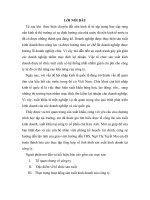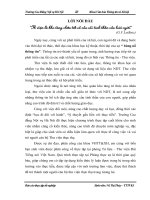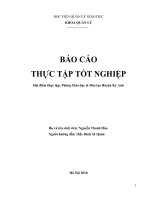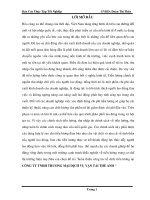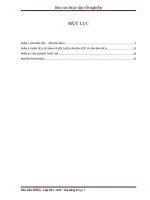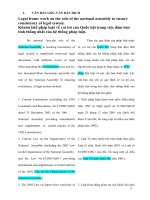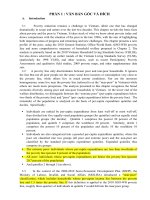Báo cáo thực tập tốt nghiệp tiếng anh (35)
Bạn đang xem bản rút gọn của tài liệu. Xem và tải ngay bản đầy đủ của tài liệu tại đây (295.31 KB, 36 trang )
Abstract
This paper examines essay-writing problems of first-year
students majoring in English at Vinh University.
Questionnaires were delivered to the first-year English
majors of the academic to elicit data about (1) students’ ideas
about essay-writing process; (2) the difficulties they face when
writing essay; (3) their suggestion of what should be done to
improve their performance.
The results of the study show that the students did not
employ necessary composing steps. They spent very little time
writing a rough draft, peer editing, and revising. The students
suggested that they needed to be provided with relevant
vocabulary background knowledge and grammar points, which
are important element to make a good essay.
The study recommends that
(1)
Essentials composing steps should not be skipped;
more time must be devoted to outlining, and the revising of
drafts should place more emphasis on ideas and organizational
aspects, rather than on mechanical mistakes alone.
(2) Explicit and concrete instructions on writing a
particular type of essays should be given, including vocabulary
and background information.
PART I: Introduction
This graduation paper reports the results of a survey
conducted investigate essay-writing problems of students
majoring in English at Vinh University, with an aim to facilitate
their essay writing and improve the quality of their writing. This
part presents the problem, the aims of the study and the
overview of the paper
1. Reasons for choosing the topic
When I first started learning writing in the English
language classroom, two issues immediately sprang to my
attention. First, my friends and I were extremely discouraged
whenever asked to write in English. Second, the product was
disappointing and did not seem to correlate with our abilities as
displayed in other aspects of their language ability, such as
speaking. As my learning developed over several years, so did
my understanding as to why the students displayed such as a
version to writing and why the-end product of the writing they
did left something to be desired.
The subjects of the study are the first-year students who
have just started their study in a new learning environment for
eight months. In the first semester, they were taught sentence
structure and paragraph-related issues such as paragraphwriting process, and basic paragraph types such as narration,
compare and contrast. At present, they are exploring the real
writing with essay writing.
As for the target students of this paper, namely first-year
student majoring in English, writing in a key skill, which may
lead to success in later years when they move on the second
and third or fourth year when most of assignments are in
written English.
Actually, they will stand a little chance of success in their
English studies in the subsequent years if they have difficulty in
writing. Therefore, any carelessness or lack of concentration or,
even worse, neglect would result in numerous consequences in
the immediate future as well as in the long run. If their errors or
inappropriate writing practices are not soon corrected, or their
essay writing problems are not solved early enough, they will
become increasingly deep-rooted and consequently irreparable.
On the contrary, with effective writing skills, students will find
their study in the following years much easier and thus probably
more fruitful.
Furthermore, essay writing does not only promise
immediate benefits in the educational setting but also future
advantages in students careers later. After graduation, many
write
reports,
business
letters,
memos
or
professional
documents in English.
While effective writing skill are so important to first-year
students, at the present as well as in the future, I have noticed
that these freshmen have many problems in essay writing and
there are accordingly quite a number of errors in their written
works.
Although
these
first-year
students
have
made
considerable efforts to improve their writing skill, many of them
are soon disappointed after series of vain attempts because
there are problems in EFL that they do not know how to deal
with or that they cannot deal with on their own. As a result,
they are discouraged to practice the skill,
On that account, something must be done to assist
freshmen’s assay writing and improve the quality of their
writing. What should be done now is to find out the causes that
hinder students from effective English writing in order to work
out feasible solutions. As far I am concerned, essay-writing
problems stem from both their language competence and their
composing processes. The causes of their ineffective writing
may lie in their weaknesses in such features of written texts as
grammar,
discourse,
vocabulary,
and/
or
inappropriate
employment of necessary techniques.
2. Aims of the study
Since essay writing is important to first-year English
majors, entails that due attention should be paid to the learning
of the skills of these subjects. This paper is one of the attempts
to do that.
The aims of this paper is to conduct a survey of essaywriting problems of first-year students majoring in English at
Vinh University, and to give recommendations to improve the
teaching and learning of the skill to such subjects.
3. Overview of the paper
There are three parts in the paper.
Part I, Introduction, shows the problem of the study, its
aims and the overview of the paper.
Part II, Literature Review there three chapters in this part.
Chapter1,
Theoretical
backgrounds
about
essays
are
introduced. Chapter 2, Some of the EFL writing problems of
Vietnamese learners are given. Chapter 3, Implications and
Recommendation, suggests tentative solutions to help students
make progresses in their essay writing. The chapter provides
recommendations to students, and teachers. This part gives the
theoretical context of the study.
Part III, Conclusion.
The author hopes that the paper brings practical benefits
to teachers and students by pointing out problems and giving
useful suggestions, thus making the learning of essay writing of
the students concerned more effective.
PART II: Literature Review.
There has been a dramatic evolution in the way that
writing is being approached in the English language classroom,
with the aim of making writing a more personal and satisfying
experience for the learner. This has evolved alongside the
development of different approaches to learning in general. And
a greater impetus has been placed on the role of writing in the
Language classroom. Writing, however, remains one of the most
difficult areas for the learners of English. This is evident in the
way that it has been neglected and/or treated poorly in the
past. Indeed, many high level English learners cannot write. As
Baskoff (1990) notes, many writing weaknesses in advanced
learners can be traced back to lack of systematic practice
during the earlier stages of learning.
This part will discuss how the concept of process writing
has raised the profile of writing, how it differs from the
traditional product approach. Some theoretical background
about essays as well as common mistakes that Vietnamese
learners often make will also be presented.
Chapter 1: Theoretical backgrounds about essays.
1.1.What is an essay?
1.1.1.Definition.
According to Oshima and Hogue (1991), an essay is a
price of writing that has more than one paragraph. It is divided
into three parts: a beginning, middle, and an end. The
beginning is called introduction, the middle is the body and thee
end is the conclusion.
An essay is nonfiction writing that employs several
paragraphs to make a point. The paragraphs in an essay all
relate to a main point that needs more clarification than a
single paragraph can provide.
An essay is a short piece of writing on a single subject. An
essay can be short as three to five paragraphs.
An essay is a piece of writing several paragraphs long
instead of just one or two paragraphs. It is written about one
topic, just as a paragraph is. However, the topic of an essay is
too long and to complex to discuss in one paragraph.
An essay is a group of paragraphs. It is developed around
a main topic.
An essay is written with a specific audience and purpose
in mind, and it has a narrowed topic, supporting details, and
unity. On the other hand, the essay also contains certain unique
elements, such as an introduction, a thesis statement, and a
conclusion.
1.1.2.Essay Types.
There are two general types of essay: informal and formal
Informal essays are writing from your own experience and
knowledge for a general audience. They are revised to improve
content, organization, and mechanics (spelling, punctuation,
sentence structure, and grammar). These essays are written in
friendly, personal, everyday language and can be handwritten
or typed.
Formal essays are written for an academic audience for a
specific purpose. The language is formal. Like informal essays,
they are revised many times to improve the content and
organization and to correct errors in mechanics (spelling,
punctuation, sentence structure, and grammar). They might use
information from other sources. They are usually typed.
1.1.1
Essay organization.
An essay has three main parts: an introductory
paragraph, a body and a concluding paragraph. (Oshima&
Hogue, 1991)
The three parts of an essay
I.
INTRODUCTION
General Statements
Thesis Statement
II.
BODY
a. Topic Sentence
1. Support
2. Support
3. Support
(Concluding sentence)*
a.
Topic Sentence
1. Support
2. Support
3. Support
(Concluding sentence)*
b.
Topic Sentence
1. Support
2. Support
3. Support
(Concluding sentence)*
III.
CONCLUSION
Restatement or summary of the main points; final comment
The Introductory paragraph consists of two pasts: a few
general statements about the subject to attract the reader’s
attention
and
a
thesis
statement
to
state
the
specific
subdivisions of the topic and/or the plan of the paper.
The first sentence in an introductory paragraph should be
a very general comment about the subject. Its purpose is to
attract
the
reader’s
attention
and
to
give
background
information on the topic. Each subsequent sentence should
become more specific than the previous one and finally lea to
the thesis statement.
The thesis statement is the most important sentence in
the introduction. It performs the same function as the topic
sentence but the covers an entire essay rather than a single
paragraph. It contains a statement of the writer’s approach to
the topic (s)he is writing about, i.e. a thesis statement that
announces the topic and presents the idea will be supported or
proved in the body paragraphs.
An introductory paragraph opens an essay three ways: it
leads into the thesis and main discussion, it arouses the
reader’s interests, and it sets the tone for the entire essay.
Many basic introductory paragraphs do follow their own
common pattern, sometime called the funnel pattern.
An essay body has several paragraphs supporting the
thesis statement. Each paragraph usually is a developmental
paragraph with a different angle of support for the thesis. Just
as the sentences in a developmental paragraph are arranged in
an order (general-to-specific, chronological, and so on) that is
easy to follow and that emphasizes the main point, so are the
paragraphs in the essay body.
The final paragraph is the conclusion, a very important of
the essay. The purpose of this paragraph is to tell the reader a
sense of completeness. This is achieved by either writing a
summary of the main points discussed in the body of the essay
or by rewriting the thesis statement in different words. The
concluding paragraph consists of a restatement of the thesis
and the final comment on the subject, based on the information
provided. There are many strategies to close an essay, an
insightful look backward, and a call to action, a quotation or an
evaluation.
1.2 Stages of writing an essay
As discussed early, compared to the product approach,
the process approach is more useful for first-year students in
many ways. First, students’ creativity is not hindered since a
rigid writing model dose not impose them just is their tertiary
education begins. Second, students who are asked or required
to spend more time on paper will think more about their topic,
retain more information, and develop insights that are more
powerful. Furthermore, students’ writing skills need practice in
order to develop. Last, students will have an opportunity to
increase their writing fluency through the process approach.
There are seven steps, i.e. choosing a topic, prewriting,
making an outline and writing a rough draft, editing a rough
draft, peer editing, revising the draft and proofreading the final
draft in the essay writing process.
1.2.1
Choosing a topic.
The very first stage is to choose a topic. In fact, either
teachers or course designers usually give students at Vinh
University the topic that is chosen so they need not choose the
topic. The necessary and important task instead is not narrow
the given topic. Restricting the given topic aids students to
determine what the major idea they need to have, which
aspects they are to explain, and which style of the writings they
have to write. Basing on determined ideas and the style of the
essay writing, students can choose words and grammatical
structures that respond the aim of the given topic.
1.2.2
Prewriting to get ideas.
After students have chosen a topic and narrowed it to a
specific focus, the next step is to get ideas. A process called
brainstorming does this. According to Oshima and Hogue
(1997), “brainstorming lets students work together in the
classroom in a small group to get as many ideas to concerning
with the topic sentence as they can write about the topic.”
There are some useful brainstorming techniques- making lists,
clustering a diagramming.
Listing is one method of getting ideas. When students
brainstorm, they quickly make a list of every word, every
phrase, every idea that comes into their minds about the topic;
some of these ideas will be good, some will be bad (Pham Doan
Thuy, 2004). After listing, students might circle or put a check
next to a good idea and cross out ideas, which do not fit, or are
duplicative.
1.2.3 Making an outline and writing a rough draft.
In the two previous stages, students have chosen the
topic and narrow it from which they could generate ideas
brainstorming. Having noted information, students should make
on outline that helps them keep their track closely because it is
considered as a plan that an architect designed to build a
house.
The
outline
should
include
examples,
reason,
explanations, definition, or personal experiences.
There are different outline forms such as the parallel
form, and the equivalent form (White & Mc Govern, 1994). The
parallel form is the form in which parts of an outline should be
written in the same form. That means all ideas should be
written in the same kind of letters an in the same grammatical
forms. For example, they all should be complete sentence, or all
nouns, or all adjectives, or all prepositional phrases, etc. The
equivalent value form is the outline in which every main
supporting point must have the same kind of the letter or
number (capital letter, for instance). Moreover, when students
want to make an outline more detailed by giving out minor
supporting points or examples, they should be indented or
written on number or letters, in the main supporting points.
When having made a careful outline, students can follow it
to write a rough draft. Writing drafts is trying out the ideas on
paper to see how they sound, how they fit the topic sentence
and where they lead (Pincas, 1994). At this step, students just
do their best to get the ideas down on the paper, using the
outline as a guide. Therefore, they can concentrate on what
they have to write, not on how they are going to write. The first
draft may contain many errors, such as misspellings, in
complete ideas, and comma errors, yet the main thing is to put
ideas into sentences.
1.2.4 Editing the rough draft.
Sine no piece of writing is perfect at first time, we should
revise what we have written. This step is very necessary
because when students revise, they can change some of what
they have written in order in order to make their essays perfect.
It is advisable that the rough draft is put away for several hours
or a few days because students may find it helpful to come
back to the paper later when they are fresh and more likely to
see the problems. At that time, students copy the again in a
neater hand or type it on a computer, if possible. In case of any
words or sentences that do not belong, students should throw
them out (Pincas, 1994).
1.2.5 Peer editing.
In this stage, students use Peer Editing Sheet to get
feedback on their essay drafts,
(Appendix 1). Peer editing is
important in the writing process. The criteria in editing are
various. Students can check his/her friends’ essay about format
including the title, indenting, margins, and double spacing. They
also check whether the essay have a good organization
including introduction, body and conclusion. In the introduction,
how many general statements are there? (Pham Doan Thuy,
2004).
Grammar,
mechanics
and
sentence
structure
are
aspects that need to be considered. One does not always see
her/him own mistakes or places where information is missing
because (s) he is too close to the essay that (s) he created. That
is why asking someone to read the draft and give feedback
about the writing always making a better essay.
1.2.6 Revising the draft.
After receiving feedbacks from friends, the next step is to
react to the comments on the peer-editing sheet or editing
checklist (Pham Doan Thuy, 2004). This does not mean that the
writer follows everything that her/ his friend suggests but has to
select what is/are the suitable points. The writer should reread
the essay to know the whether making changes is necessary.
Then, (s) he alters some needed points and rewrite the essay.
1.2.7 Proofreading the final draft.
This step is to proofread the drafted paper to check for
grammar, sentence structure, spelling, and punctuation to
correct if there are such errors in the writing. Students check
over
each
sentence
for
correctness
a
competence:
no
fragments, or choppy, or run-on sentences. Students also check
over each sentence for subject and a verb, subject- verb
agreement, and correct the verb tenses, etc. (Dave 1998).
Chapter 2: Vietnamese learners’ EFL writing problems
2.1 Problems concerning features of written texts.
2.1.1 Structural problems.
One of the most obvious writing problems of Vietnamese
learners are structural problems. Vietnamese students writing in
English might be confused with sentence patterns, word order,
and the information structure of English sentences, which
sentence from those in their mother tongue.
Adjectives are common in both English and Vietnamese
languages, yet Vietnamese writes are usually confused with
their order in noun phrases. They might write a phrase like this:
country cottages charming.
(Correct: charming country cottages.)
An understandable explanation for this is that in
Vietnamese language, the adjectives are put after nouns.
However, in English, this order is upside down.
Another typical error is the omission of a certain sentence
element. For example,
I have
just bought a shirt, costs $ 10.
(Correct. I have just bought a shirt. It costs $10.)
One of the possible causes, in my opinion, is that the
absence of subject or a certain element is common in
Vietnamese sentence, while the phenomenon is rare in English.
In the above Vietnamese sentence, it is not necessary to have a
subject, for it can be understood.
Concerning sentence patterns, one big problem for
students is the choice of correct kind of structure (a phrase or a
clause) to follow a certain verb:
He wanted that should stay with him
(Correct: He wanted me to stay with him.)
On the other hand, the writing may make such mistakes
as:
The boss said me to go and see him in his office.
(Correct: The boss told/ asked me to go and see him his office.)
2.1.2 Problems in support, unity, coherence.
Though support, unity and coherence are the
essentials of textual development in any language, there are
observable differences between cultures in the amount and
organization
of
the
support
needed.
Non-native
writer
attempting to write in a second language
May wrongly assume that the social conventions that
exist in their native language are also operative in their second
language so that, for example, structuring an argument or
supporting a main point are the same in both cultures. Making
these assumptions can result in being misunderstood and less
effective writers. (Brock & Walters, 1993, p. 171)
2.1.3 Mechanical problems
Mechanics are those aspects of writing such as spelling,
the use of hyphens, capitals, abbreviations and numbers, which
are often dealt with in revision of editing stage of writing.
According to Raimes (1983), while speaker pronounce
and
deal
with
sounds,
writers
spell
and
struggle
with
orthographic forms of words, especially long polysyllabic ones.
If speakers use pauses and intonation then writers use
punctuation. Just as mispronunciation or improper intonation is
embarrassing
and
misleading,
any
mistakes
in
spelling
punctuation may be confusing and harmful to one’s written
work. For example, “Let’s eat grandfather before we go.” Such a
sentence would imply the writer is cannibal. Failing to capitalize
and use commas has greatly damaged the expression. The
sentence should have writing like this, “Let’s eat, Grandfather,
before we go.”
Rather common mistake among ESL Vietnamese are
comma splices, punctuating two sentences with a comma
instead of a period between them, or omitting punctuation
between sentences.
2.2 Problems concerning composing processes.
2.2.1 The use of translation.
When writing, students often work out a sentence in their
own language and then try to translate it word by word.
Consequently,
their
texts
contain
odd
expressions,
ungrammatical phrases and nonsensical sentence. If employed,
translation damages not only grammar but also vocabulary, for
students
force
themselves
to
encounter
sophisticated
vocabulary and get it wrong.
Since errors will be inevitable if translation used, writing
researchers and instructors all advise not using translation. Ellis
(1992), for instance, warns writers not “to compose what you
want to say in your own language first and then translate it,
“but trains them to thing in English” to activate English they
already know”.
2.2.2 Writing sub-processes skipped.
As mentioned in the previous part, there are seven steps
of writing, yet students do not always follow all these steps.
Many Vietnamese teacher and most Vietnamese writers seem
to view writing quite a simple process. First, teacher gives a
topic, then, students write a composition. After finishing the
essay, students hand in them to the teacher. The last phase is
when the teacher grades and returns the composition. (Forseth
et al, 1995)
Poor writing may be traced not only to weaknesses in
grammar or vocabulary but lack of an outline as well. Having an
outline is very helpful, especially for those who usually are
stuck in the middle of the writing process. These writers are not
systematically
using
strong
strategies
such
as
planning,
brainstorming. (Bermudez & Prater, 1990)
Another “bad” practice of non-native writers is that they
do not revise their papers intensively and extensively enough. A
lot of them never revise at all. Since students save very little
time for the revising step and they revise mainly for mechanical
mistakes, there are still many errors in their written works, and
the text may not be unified or coherent.
It should be noted that it is not easy for L2 writers to
consider all those factors during their revision. Silva (1993) has
found this result: that revision in L2 writing is more difficult and
more of a preoccupation than it is in L1 writing. Silva (1993)
found out that there is less “revising by ear””, i.e. making
changes based on what ‘sounds” good.
2.2.3 Poor background knowledge.
Given an unfamiliar topic, it is not easy for non-native
writers to write acceptably well even in their first language,
much less in foreign language. Writers may not have enough
ideas to write down or, even worse, they have nothing to write.
The topic may be one that (s) he might never have heard of and
(s) he takes no interest. Writing involves not only how to say but
also what to say. This question of content, what to say, may
become more serious and is more likely to occur as for the L2
writers who are forced to write rather than they themselves
volunteer to write. Taylor (1981) suggested that essay writing
might be viewed as “a simultaneous two-way street, a dynamic,
creative process of give and take between content and written
form” writing then, in his words, is a creative discovery
procedure characterized by the dynamic interplay of content
and language.
2.2.4 Cognitive problems.
The last difficulty area in English writing for non-native
writers is due to cognitive differences. The problems are at the
deepest level, coming from the difference in culture and
cognition across the two cultures. It is because “different
languages divide reality differently”, say Brock & Walters
(1993), that there are differences across languages, regarding
grammar, lexis; discourse structuring, stylistic expectation.
Culture undoubtedly plays an important part in language
teaching programs. Moreover, it seems to be more significant
as for writing in particular. The most obvious reason is that
when a person writes, he has more time to think about what to
write then the speaker who would have to react to the other
almost immediately.
2.3 Data Analysis and Discussion.
The preceding chapter has described the methodology
used in the study. In this chapter, the students’ responses to the
questionnaire are analyzed and discussed. The aim of data
analysis is to identify challenges students are facing while
writing an essay; and what is still inappropriate or wrong in the
essay writing activities of students. Feasible solutions therefore
are suggested to improve their EFL writing skills.
2.3.1 How students write essays?
When asked the frequency of practicing writing steps, 43%
of
the
students
revealed
that
they
sometimes
do
the
brainstorming, 37% of the students revealed that they (very)
often do the brainstorming. Most of them explain that
brainstorming help them find as much ideas as possible and
avoid interruption while writing. And 20% of the students rarely/
never dose brainstorming before writing, which is a positive
indication because this step is indispensable to facilitate writing
process.
Figure1. Brainstorming.
The survey also shows that three fourths of first-years
students (53/100) often make outlines. The reason they offer is
to avoid going off the topic and to arrange the essay
systematically and logically. The same result can also be seen
at the revising and proofreading stage; over half of the students
often practice. Especially, there is a big gap between the
number of students who (very) often proofread and those who
sometimes/ rarely do.
Freq Very
Often
Sometim Rarely
Never
uency
often
es
Stages
Outlining
10
43
40
7
0
Revising
(10%)
7 (7%)
(43%)
36
37
17
3
Proofreadin
23
(36%)
47
23
7
0
g
(23%)
(47%)
Figure 2. Outlining, revising and proofreading.
It is noticeable that students did not pay due attention
to write a rough draft. Only a small number of students spent
time writing a primary essay although many of them already
wrote an outline as what they said previously. Is addition, some
of them argued that it is a waste of time to write a draft.
Figure 3. Writing a rough draft.
Concerning peer editing, shame was one of the reasons
of the fact that students did not want their essays to be
corrected by the friends. Some students were afraid to lose
their face if their friends knew their mistakes and told the
others. Moreover, as some students said, their friends were not
knowledgeable enough to correct the mistakes and the essays
might be worse.
Figure 4. Peer editing.
Teacher’s remarks seem to be more reliable than friends’
are. The majority of students believed that their teachers gave
them feedbacks that were more valuable since teachers are
usually better than students are. They also admitted that
feedbacks with compliments were more effective than a mere
mistake correction. Students felt more motivated to take
advantage of their strengths and had a feeling that their efforts
were rewarded.
Figure5. Teacher editing.
2.3.2 Writing aspects need to be improved.
After answering questions about their writing practice,
self-evaluation of their writing capacity and the difficulty degree
of writing stages, students were requested to raise their voices
about aspects need to be improved for the development of
essay writing skills.
The most remarkable feature as can be seen from the
chart is a high demand on vocabulary; 70 percent of the
students had a common idea about their need of lexical
resources. This is a comprehensible idea because in the
previous question, they said that they were not good at words
and phrases. If grammar is skeleton, words and phrases are
muscle. Therefore, a logical and scientific way of vocabulary
learning is what they really needed.
Grammar is another field that students needed to improve, Grammar very importance.
Students needed more instructions and explanation of grammar points since at University,
students focused much on new theories about essay, which they did not touch upon on at high
school. Meanwhile, they were confident about grammar they learnt at high school, and this
leads to worse grammar capacity.
Writing
Need
area
Vocabula
Need least
18
ry
2
most
3
0
(60%)
Grammar 13
(10%)
9
4
(30%)
7
6
(23%)
4
9
15
8
(20%)
3
0
(13%)
6.
6
4
(23%)
Backgrou 4
Figure
9
0
(27%)
Mechanic 7
nd
4
0
(43%)
8
Style
7
Degree
(50%)
of
vocabulary,
grammar,
style,
mechanic and background.
This chapter has analyzed and discussed the result of the
survey. It has pointed out that many things regarding students’
composing process and learning of EFL writing must be
rectified. It is noticeable of the students did not employ
necessary composing techniques to produce an essay in
English.
Clearly enough, something must be done to facilitate
students’ essay writing activities and improve their writing
efficiency. The following chapter will provide a number of
recommendations to three important parties in language
teaching and learning, teachers and students.
Chapter 3: Implications and Recommendations
This chapter presents the implications of the study and
provides recommendations to facilitate first-year students’
essay writing activities and improve the quality of their writing.
The recommendations are introduced inn two main sections: to
teachers and to students.
3.1 Implications.
The study has several significant implications for the
teaching and learning of essay writing of first-year students at
English department, Vinh University.
1.
.
Writing involves recursive composing processes rather than
a linear process of
writing down ready-made sentences that
the writer has already had in mind (Benson & Heidish 1995)
In chapter 2, seven steps of writing process have been
presented, i.e. choosing a topic, prewriting, making an outline
and writing a rough draft, editing the rough draft, peer editing,
revising the draft and proofreading the draft in the essay writing
process (White and Mc Govern, 1994).
However, the paper has pointed out that many student
writers did not spend enough time revising for anything other
than morphological and mechanical mistakes.

